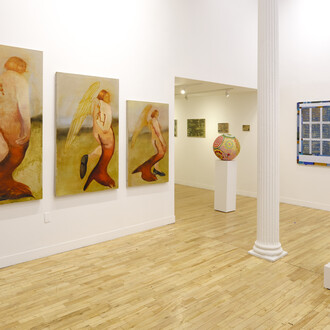No Gallery is proud to present To Dream of Smoke, Allen-Golder Carpenter’s debut New York solo exhibition. These all-new works continue to expand narratives around regional identity, popular culture and the contemporary black experience already explored within Carpenter’s burgeoning practice.
Challenging both aesthetic value and history in material and imagery, to dream of smoke encourages viewers to more deeply consider the origins (cultural and practical) of media, fashion, and products they consume. Carpenter’s work utilizes regional identity as a means of psychogeographical analysis, questioning the communicability of objects and aesthetics as they move from hyper-specific cultural and social spaces into mainstream and pop culture lexicons.
Although the works in the exhibition make use of the aesthetics of hip-hop culture as their dominant point of reference, the show isn’t really about hip-hop music itself, but primarily uses it as a vehicle to open up a dialogue around people's proclivity towards the consumption of things they don’t fully understand, often out of a reluctance to accept the reality that produced said thing, as well as touching on other universal and inescapable topics, like masculinity, pride, mental health, posturing, incarceration, cultural exchange, censorship and social programming, dissecting rap culture as a by-product of the intersection of all of the aforementioned themes.
A foundational reference for what became this body of work is what’s known as a “switch”, an illegal black-market attachment for Glock handguns that when attached, converts them into fully automatic weapons. Its name appears frequently in the lyrics of many street rap songs. My fascination with it stemmed, in part, from the fact that most people have no idea what it even is, and couldn’t tell you what it was even from looking at it, but this object that’s no larger than a quarter could land you in prison for close to a decade if you’re unlucky enough to be caught with one. That kind of sentencing, and much of policing and punishment is predicated on the “potential” to cause harm, instead of actual harm caused.
Rap music because of its “potential” to harm, like other mediums, has battled with censorship. A battle for its right to exist. The larger installation of this project is a set of images of rappers, juxtaposed against censored versions of those same images. Compiling these images I couldn’t help but think of how some of these rappers have reputations of being genuinely terrible people, that are complicit in the reproduction of harmful elements of our culture. But does just covering them up, and blurring them out, make consuming their work ok? Can we condemn the actions of the producer while still supporting their production? I try to think about my own role in reproducing harmful ideas.
The piece titled “Self Portrait”, containing a ski mask stretched over a bag of powdered sugar, comes from when I used to wear ski masks to try and look “tough”, and unapproachable. Until one time someone came right up to me and felt at ease talking to me because of my soft, even sweet eyes (their words not mine). Begging the question, what in me made me want to intimidate others in the first place? Maybe it’s a defense mechanism?
The exhibition title itself comes from the Cities Aviv track “To Dream of Smoke”, opening with a monologue by Jey-Bird-Woe, describing a fictional character of their design, “Joshua”, that is meant to encompass all the different black boys who resort to less-than-legal means of advancing their position in society, at an attempt to re-humanize the perception young black men in the street, the very peoples that hip hop itself came from.
This theme is exemplified by the presence in the show of Tay K, a then-teen rapper that rose to internet fame with his viral music video “The Race”, shot while on the run for capital murder charges. He was Painted as a boogie man in the media, and teenage me believed it. Till I learned his story, born into a cycle of violence and struggle that I’ve seen claim many kids I grew up with. A hard to escape cycle that sets you up to fail from day one. How much can we judge the actions of a child fighting for survival, what if instead of just punishing him, we punished the society that failed him? The installation features one of his first pictures from jail at the start of his 55-year sentence; the post sat at 1 million likes, next to an image of the platinum certification for his song having sold a million copies. It begs the question how many people that pressed play even knew anything about him, and if they did, did they even care?
(Allen-Golder Carpenter)
Allen-Golder Carpenter, (b. 1999 in Washington DC), is a gender nonconforming interdisciplinary artist, designer, poet, author, and activist. Their work as an artist serves to reconcile the various aspects of their identity as they relate to themselves and the world around them. In 2023 Carpenter exhibited internationally completing his first solo exhibition at Screw Gallery in the UK and Galerie Kandlhofer in Vienna. Additionally, Carpenter has been included in multiple group shows in White Columns, No Gallery, Housing NY, and Von Ammon Co. Allen-Golder Carpenter currently lives and works in Washington DC.














